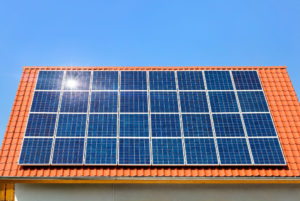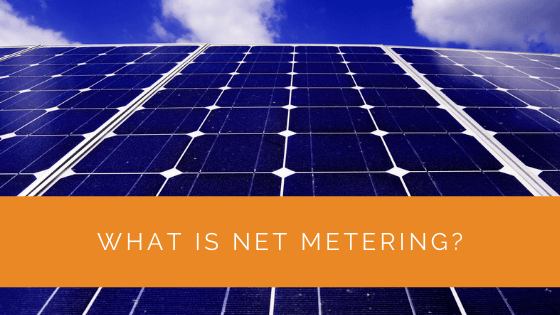The overuse of fossil fuels has not only contributed to global warming but made our planet more vulnerable to frightening storms, wildfires, and other extreme weather events.
Solar energy is one way we can help reverse this, and thanks to technological advancement in this field, it is more efficient and viable than ever.
 What once took numerous big solar PV panels over a day’s worth of sunlight to generate can now be done by a few smaller PV panels in just a few hours.
What once took numerous big solar PV panels over a day’s worth of sunlight to generate can now be done by a few smaller PV panels in just a few hours.
What was once not viable to homeowners due to the hefty installation costs is now affordable and incentivized by federal and state governments.
Solar technology continues to advance, which is excellent! However, one of the best advancements does not involve the composition or physical setup of the solar panel system but how the energy generated is stored and used.
Net metering is the answer to this and has become quite a popular concept to solar energy enthusiasts. But just what is net metering, how does it work, and how does it benefit the consumers?
Contents
Key Takeaways
- Net Metering, also known as Net Energy Metering (NEM), is a billing system that credits solar energy system owners for the excess electricity they generate and feed back into the grid.
- Net Metering allows solar users to reduce or eliminate their electricity bills, as they are billed only for their net energy consumption, making it financially advantageous.
- The benefits of Net Metering include reducing the need for backup generators and battery storage, easing pressure on the grid, minimizing network upgrades, and providing significant utility bill savings for solar system owners.
What is Net Metering?
Also referred to as Net Energy Metering (NEM), Net Metering is a power consumption billing system that credits those who have a solar energy system for the electricity they put into the grid.
Given that most solar power systems today are tied to the grid, if yours generates more electricity than you consume, the excess is sent to your utility company giving you credit for the electricity your solar energy system generated.
 You can think of it as an incentive program, similar to getting a bonus at work, where there’s an exchange between you and the utility company.
You can think of it as an incentive program, similar to getting a bonus at work, where there’s an exchange between you and the utility company.
More often than not, solar PV systems generate more electricity than most households use during the day. If your house is net-metered, the meter will run backwards and provide a credit against the electricity you use at night or any other time where your electricity use goes beyond the solar system’s output.
Keep in mind that you are only billed for your net energy use, and this is how most people with solar power systems end up paying nothing for electricity consumption.
How Does Net Metering Work?
With an understanding of what Net Metering is, here is an explanation of how it all works:
- Your solar PV panel system generates the most electricity during daylight hours when most people are at work or school.
- This excess electricity is fed to the electricity grid.
- If your solar PV system is not producing adequate electricity, you can draw from the electric utility’s grid, just like before you went solar.
- It is this back and forth between the grid and your system that ascertains your shortages are met and the excess power production is still utilized.
- The total electricity consumption is monitored, and at the end of the month, you are only required to pay for the net power consumption.
- If the energy your solar system generated is more than your household consumed during that month, the utility company will credit your bill, which is known as a solar panel bonus.
What Are the Net Metering Requirements?
The primary requirement for net metering is for your system to be grid-tied. This means it needs to be connected to the utility company to enable energy transfer from your solar power system to the utility. However, when you look at the benefits, this is not a significant concern.
What Are the Benefits of Net Metering?
Gets Rid of the Need for Backup Generator and Battery Storage
Unlike off-grid solar power systems, you do not need a battery storage system while utilizing net-metering as the additional power is fed to the utility grid. Also, it eliminates the need for generators as the grid ideally acts as a backup generator.
Reduces Pressure on the Grid
Residential solar PV systems benefit both utility companies and their users as they help minimize the amount of stress on the electricity distribution system.
Since solar users are not drawing power from the grid, but utilizing their own, there are fewer households drawing power directly from the grid.
In addition, when a solar power system sends your energy to the electric grid, that power is used by other non-solar consumers to meet their demands. This reduces the pressure from the utility plants even further.
Less Network Upgrades
 Solar power users not only conserve energy, ensuring there’s adequate for everyone, but they ideally help power the electric grid.
Solar power users not only conserve energy, ensuring there’s adequate for everyone, but they ideally help power the electric grid.
The excess electricity from their solar systems is fed back to the grid, which lessens utility companies’ need to spend more money on infrastructure upgrades.
Also, it helps minimize transmission line congestion which can lead to blackouts and other inconveniences that call for repairs and upgrades.
Utility Bill Savings
Perhaps the best thing about net metering to solar users is the utility bill savings. This billing mechanism can substantially lower your monthly electricity bill. If you have a solar PV system that is big enough, you can potentially eliminate all your energy use costs.
This leads to tens of thousands of dollars in savings during the system’s lifespan. For instance, if your monthly bill was $100 on average, and your solar system covers all your electricity needs, that equates to $1,200 in savings for one year.
However, it’s important to note that your electricity bull might have some fixed costs that net metering may not be able to eliminate.
Experience Solar Excellence with Us!
Trust in Solar Panels Network USA, where our seasoned experts deliver top-quality solar solutions for homes and businesses nationwide. With a legacy of countless successful installations and a commitment to sustainable energy, we’re your reliable partner in the solar journey. Ready for a brighter, eco-friendly future? Call us now at (855) 427-0058 and harness the power of the sun!
Conclusion
As you can see, there so many appealing benefits that net metering has to offer. If you are yet to join the party, it’s high time you did.
About the Author
Solar Panels Network USA stands at the forefront of solar energy solutions, driven by a team of seasoned solar engineers and energy consultants. With over decades of experience in delivering high-quality solar installations and maintenance, we are committed to promoting sustainable energy through customer-centric, tailored solutions. Our articles reflect this commitment, crafted collaboratively by experts to provide accurate, up-to-date insights into solar technology, ensuring our readers are well-informed and empowered in their solar energy decisions.

